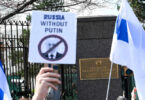David Vergun
WASHINGTON: Joint All-Domain Command and Control, aka JADC2, is a system being developed that aims to connect any sensor to any shooter in any domain across the joint force, enabled by artificial intelligence for combined effects.
Defense Department officials discussed that system at the National Defense Industrial Association webinar panel on “Enabling the Joint Warfighter: JADC2,” Feb. 24, 2022.
Although not officially titled JADC2, work on JADC2-like concepts has been going on for more than two decades, said Anthony Smith, director, command and control, communications infrastructure and chief information officer.
After 9/11, the department, with the services, created an intelligence, surveillance and reconnaissance system linked by satellite communications, ground relays and data dissemination nodes that was good at targeting terrorists, he said.
However, that system didn’t handle jamming, spoofing and other things that would be expected in a fight with a peer adversary, he said. Also, each service had its own system which did not communicate well with other services, requiring postproduction modifications and a series of relays and translation utilities to integrate the disparate capabilities.
“The near term for JADC2, I think, is going to be building stopgap fixes,” he said.
For the long term, there will need to be software-defined systems and an open system architecture.
Hardware-based systems are just too hard to fix and too hard to modify, he noted, as it takes five to 10 years to replace, particularly in aircraft.
“The long-term effort is coming up with new joint software-defined radio systems and programs so that we will all have the ability to quickly change the stuff on the fly. And, as our enemy develops new ways of jamming and detecting and finding and fixing our forces, we can quickly change on the fly and add fixes,” he said.
Zero-trust is also important to the JADC2 system, he said, meaning it must not trust information coming in unless it is verified that it’s not adversarial in origin.
Another important piece of JADC2 is that it must be able to communicate with allies and partners, he said.
Michael Zatman, principal director, fully networked command, control and communications for the office of the secretary of defense for research and engineering, said the service networks are currently not all equal in efficiency and effectiveness and the joint network is only as strong as the weakest component.
Therefore, synchronization of effort across the services is important, he said.
Having said that, Zatman noted that the services are doing some creative and useful work in the JADC2 realm.
The JADC2 system must also be resilient in the face of a highly contested battlefield that includes enemy electronic warfare, cyber and kinetic attacks, Zatman said.
“In the future, we’re also looking at autonomous systems taking on our adversaries’ autonomous systems. So, who’s going to win that battle? Well, it’s partly about who comes to the better answer in terms of information processing and decision support,” Zatman said.






